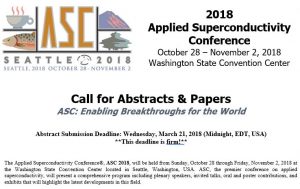Call for Abstracts Now Available
Click on the image below to open the Call for Abstracts in PDF format.
Click here for Abstract Submission information.
Submissions shall generally address at least one of the areas below. Please review the complete list of technical submission categories further below on this page.
-
-
- Advances in the science of superconductors relevant to applications. Abstracts describing basic materials, films, or artificial structures should discuss properties interesting for applications, forms used in applications such as elementary conductors or simple circuits, or structural or compositional aspects that potentially lead to use in a device. Theoretical content should address topics relevant to applications, operations, or behavior of practical systems. Experimental studies, test methods, and data should relate to aspects of superconductivity important for applications in some way.
- Advances in superconducting technology. Abstracts may describe concepts, design, modelling, manufacturing or fabrication, and operation or implementation of superconducting devices or components. Extensions of conventional technologies by the use of superconductivity should emphasize the role of superconductivity in the device or component. Abstracts may describe non-superconducting technologies that are required for the use of superconductors, such as insulation, provided that the primary discussion is focused on applied superconductivity.
- Integration of superconducting devices and components in systems. Abstracts may discuss sub-systems or full systems comprised of components such as cables, magnets, detectors, circuits, and so on. Discussions may include components and processes that support superconducting devices, such as cryogenic systems supporting superconducting magnets. Studies of power devices, transportation systems, electricity transmission, energy storage, and other systems that use superconducting components should emphasize the role of superconductivity or the particular aspects of superconductivity important to the system or application. Cryogenics, non-superconducting materials at cryogenic temperature, power supplies, power electronics, and other ancillary topics may be considered provided the connection to applied superconductivity is clear. Also, abstracts may describe facilities to verify operation of components, report system tests, or describe the status of superconducting systems and projects using superconducting components.
- Advances in the science of superconductors relevant to applications. Abstracts describing basic materials, films, or artificial structures should discuss properties interesting for applications, forms used in applications such as elementary conductors or simple circuits, or structural or compositional aspects that potentially lead to use in a device. Theoretical content should address topics relevant to applications, operations, or behavior of practical systems. Experimental studies, test methods, and data should relate to aspects of superconductivity important for applications in some way.
-
Note that the numbers are related to editorial subject areas of the IEEE Transactions on Applied Superconductivity (TAS). A submission category must be selected during abstract submission.
ELECTRONICS SUBMISSION CATEGORIES
Superconducting Electronics
11 Device fabrication: junctions, nanowires, epitaxial films, low-loss dielectrics
12 Packaging and systems integration
13 Digital circuits: conventional and energy efficient designs
14 Mixed signal circuits (analog + digital)
15 Microwave devices and components: low-noise amplifiers, mixers, filters
16 SQUID design and applications: nanoSQUIDs, scanning, SQIF, biology, geology, NDE
17 Quantum information processing: qubits, QKD, readout, materials, fabrication
18 Novel electronics: mesoscopics, topological circuits, metrology, metamaterials
Superconducting Detectors
21 Transition-edge sensors (TES) devices
22 Nanowire single-photon detectors
23 Other equilibrium (thermal) detectors: SNS, penetration-depth
24 Other non-equilibrium (non-thermal) detectors: SIS/HEB mixers, STJ/MKID photon
25 Instrumentation and readout of superconducting detectors
LARGE SCALE SUBMISSION CATEGORIES
Large Superconducting and Related Systems
31 Large detector arrays
35 Superconducting RF
36 Levitation, transportation, and propulsion
37 Magnetic separation and other applications
38 Cryogenics for superconducting devices and system integration
Superconducting Magnets
40 Accelerator magnets: dipoles, quadrupoles, correctors
41 Accelerator magnets: wigglers, undulators, special magnets
42 Fusion magnets
43 Very high field and NMR magnets
44 Magnets for medical systems
45 Detector Magnets
46 HTS magnets
47 Magnet stability, magnetization effects, AC losses and protection
48 Cables (HTS, LTS), CICC, and current leads
49 Magnet design and analysis techniques
Superconducting Electric Power
50 Grid study with superconducting devices
52 Motors, Generators, and other rotating machines
54 Transmission and distribution cables and links
55 Transformers
56 Fault current limiters
57 Energy storage
59 AC loss in superconducting electrical power devices
Measurement and Testing
90 Measurement and experimental techniques
95 Test facilities and instrumentation
MATERIALS SUBMISSION CATEGORIES
Conductor R&D
60 NbTi, Nb3Sn, and other niobium-based wires and tapes
62 MgB2 wires and tapes
64 Bi-oxide wires and tapes
66 Coated conductors
68 Bulk conductors
69 Other wires and tapes
Materials Important for Applications – Structure, Formation, Basic Properties
70 General superconductor materials science
71 Metals and simple compounds
72 Cuprates and related materials (buffers, templates, etc)
73 Pnictides and related materials
74 New and emerging materials including Fe-chalcogenides
75 Artificial structures, thin films, and multilayers
77 Insulation and dielectrics
78 Ancillary materials for superconducting applications
Properties Important for Applications
80 Critical current and flux pinning
82 Magnetization and time-dependent losses
84 Mechanical properties, strain dependence
86 Critical temperature and critical fields
88 Other properties
